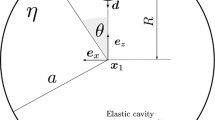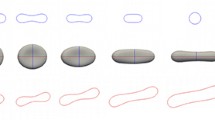Abstract:
We study dynamics of a deformable entity (such as a vesicles under hydrodynamical constraints). We show how the problem can be solved by means of Green's functions associated with the Stokes equations. A gauge-field invariant formulation makes the study of dynamics efficient. However, this procedure has its short-coming. For example, if the fluids are not Newtonian, then no Green's function is available in general. We introduce a new approach, the advected field one, which opens a new avenue of applications. For example, non-Newtonian entities can be handled without additional deal. In addition problems like budding, droplet break-up in suspensions, can naturally be treated without additional complication. We exemplify the method on vesicles filled by a fluid having a viscosity contrast with the external fluid, and submitted to a shear flow. We show that beyond a viscosity contrast (the internal fluid being more viscous), the vesicle undergoes a tumbling bifurcation, which has a saddle-node nature. This bifurcation is known for blood cells. Indeed red cells either align in a shear flow or tumble according to whether haematocrit concentration is high or low.
Similar content being viewed by others
Author information
Authors and Affiliations
Additional information
Received 19 December 2001 / Received in final form 31 May 2002 Published online 2 October 2002
RID="a"
ID="a"e-mail: chaouqi.misbah@ujf-grenoble.fr
Rights and permissions
About this article
Cite this article
Biben, T., Misbah, C. An advected-field method for deformable entities under flow. Eur. Phys. J. B 29, 311–316 (2002). https://doi.org/10.1140/epjb/e2002-00307-6
Issue Date:
DOI: https://doi.org/10.1140/epjb/e2002-00307-6




